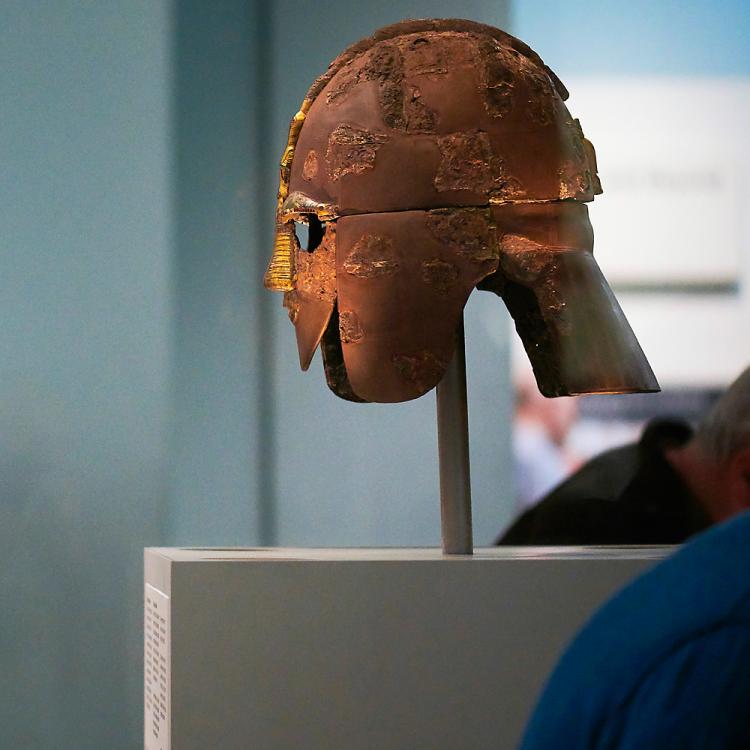Visiting the gallery
Opening times
Daily: 10.00–17.00 (Fridays: 20.30)
See full opening hours
Advance booking advised
Gallery audio guides
Listen on the Audio app, available on the App Store and Google Play.
Spanning over 700 years, Room 41 traces the story of Europe from AD 300.
The centuries AD 300–1100 witnessed great change in Europe. The Roman Empire broke down in the west, but continued as the Byzantine Empire in the east. People, objects and ideas travelled across the continent, while Christianity and Islam emerged as major religions. By 1100, the precursors of several modern states had developed.
Europe as we know it today was taking shape. Room 41 gives an overview of the period and its peoples. Its unparalleled collections range from the Atlantic Ocean to the Black Sea, and from North Africa to Scandinavia. The gallery's centrepiece is the Anglo-Saxon ship burial at Sutton Hoo, Suffolk – one of the most spectacular and important discoveries in British archaeology.
Take a virtual tour
Explore the impressive Anglo-Saxon artefacts found at the Sutton Hoo ship burial in Room 41 using Google Street View.
Gallery facts
- By AD 500, invasions, religious infighting and political strife had disrupted life in the Roman Empire and it eventually broke down, only enduring in the east as the Byzantine Empire.
- A few miles from the Suffolk coast, the Sutton Hoo ship burial was one of the most exciting discoveries in British archaeology, and one that profoundly exploded the myth of the 'Dark Ages'.
- There are two Sutton Hoo helmets in Room 41, the original and a replica showing how the original previously looked. The original helmet is extremely rare, only one of four known complete helmets from Anglo-Saxon England.
- At the heart of the Sutton Hoo ship burial was a chamber surrounded by riches from Byzantium and beyond, pointing to the existence of international connections.
- The origin of the term 'Viking' is uncertain, perhaps coming from Old Norse words for pirates, seaborne expeditions, or an area in south-eastern Norway called Viken.
- A double-edged sword, such as that on display, was the most prestigious weapon used by Vikings, only available to high-status warriors.
European timeline, AD 300–1100
AD 300–1100
Celtic Britain and Ireland
AD 300–500
The Roman Empire and beyond
AD 330–650
The Byzantine Empire
AD 400–750
Great migrations
AD 450–1100
Anglo-Saxon England
AD 750–1100
The Vikings
An introduction to Sutton Hoo
In 1939, Edith Pretty, a landowner at Sutton Hoo, Suffolk, asked archaeologist Basil Brown to investigate the largest of several Anglo-Saxon burial mounds on her property. Inside, he made one of the most spectacular archaeological discoveries of all time.
Beneath the mound was the imprint of a 27m-long (86ft) ship. At its centre was a ruined burial chamber packed with treasures: Byzantine silverware, sumptuous gold jewellery, a lavish feasting set, and, most famously, an ornate iron helmet. Dating to the early AD 600s, this outstanding burial clearly commemorated a leading figure of East Anglia, the local Anglo-Saxon kingdom. It may even have belonged to a king.
The Sutton Hoo ship burial provides remarkable insights into early Anglo-Saxon England. It reveals a place of exquisite craftsmanship and extensive international connections, spanning Europe and beyond. It also shows that the world of great halls, glittering treasures and formidable warriors described in Anglo-Saxon poetry was not a myth.
Edith Pretty donated the finds to the British Museum in 1939, and they now form a stunning centrepiece to this gallery. The site at Sutton Hoo is managed by the National Trust. Visit the National Trust page about Sutton Hoo to find out more.
Accessibility
- A large print guide is available.
- Some objects in this collection feature on the British Sign Language multimedia guide. This resource is temporarily unavailable. You can access a selection of BSL films on your own device.
- Some objects in this collection feature on the audio description guide, available on Soundcloud.
- Seating is available.
- Step-free access.
- View sensory map.
Visit Accessibility at the Museum for more information.















